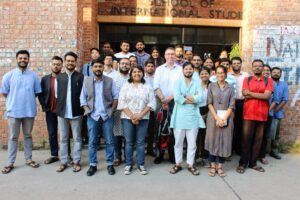
This blog provides discussion highlights for Sunday IR Cafe #14. Conducted on 8th May 2022, the discussion covered Power Transitions: Thucydides Didn’t Live in East Asia.
CORE ARGUMENTS:
- IR Scholars have been trying to grapple with the issue of power transition between a rising China and the declining U.S., with most predicting a dangerous transition rather than a peaceful one. The argument for the possibility of a dangerous power transition is rooted in the historical experience of European geopolitics. Kang and Ma, however, take umbrage with applying the power transition theory (based on the modern, western experience) to study the phenomenon in East Asia. Based on two power transition case studies rooted in pre-modern East Asian history, Kang and Ma provide three policy prescriptions relevant to the current context. First, power vacuums can be as problematic as power transition, and states should worry about it. Second, domestic weakness rather than external challenges can also lead to the fall. Third, challenges from smaller powers are also significant.
- Imjin War (1592-1598) serves as the first case study rooted in East Asia that challenges the conventional wisdom on the power transition. Japan, a revisionist state much smaller than China, initiated the war without any explicit consideration of the distribution of power. Empirical evidence shows the Japanese invasion was motivated more by status, economic, and domestic political considerations. Further, other states’ reactions to Chinese hegemony do not follow the balance of power logic, as Korean and Japanese states did not form a balancing coalition against China. Rather bandwagoning was more prominent.
- The Ming-Qing Transition (1644-1683) was mostly a result of the power vacuum, as the Ming dynasty collapsed due to rebellion and political crises. The Manchus, consequently, moved into space. The internal drivers of the crisis, thus, were more deterministic in power transition than the external threats from a rising power.
- According to Kang and Ma, China has already peacefully completed a power transition in East Asia. Despite being an economic powerhouse, Japan has shown an unwillingness to make the bid for regional hegemony. East Asian states have increasingly integrated with the Chinese economy, which has fostered economic dynamism in the region. Military spending as a percentage of GDP has gone down in the region. In the backdrop of the Trump administration’s erratic America First policy, Beijing has sought to build an alternative regional institutional architecture that these regional states have embraced. Unlike what realists would predict, China’s rise has not translated into the materialisation of a regional arms race.
- Hence, the historical East Asian experience warrants three lessons for policymaking today. First, the fall of a hegemon can occur not due to external threats but also because of domestic problems. As such, both China and the U.S. need to take stock of domestic problems and set their houses in order. Second, not just power transitions but power vacuums can also be dangerous. Consequently, the U.S. should not cede the leadership role and active participation in the regional economic and security arrangements. Third, not just the great power rivalry but threats from smaller powers can also be destabilising. The destabilising impact of the nuclear threat posed by North Korea, thus, needs to be accounted for.
- The U.S.-China power transition is a global one, not regional one. The U.S. has escalated both its rhetoric and hard balancing measures against China, but regional states think otherwise. Even if the American grand strategy prefers projecting China as a threat, their intentions and preferred policy approaches differ. In other words, European history cannot be the guide for Asia’s future. The problem lies with the lack of adequate scholarly engagement with East Asian history and culture in western academia. Complex societies rooted in a distinct historical and cultural milieu demand creative solutions, not prescriptions emanating from theories built on Western experiences.
DISCUSSION:
- The Western domination of the epistemological and historical methods that inform theorisation could have real-world consequences by defining and limiting the paradigm in which new transformations of global politics are being understood and explained. From this perspective, it is crucial that non-Western imaginations of history also find space in the ways through which we understand, explain, imagine and act on the ‘international’. For examining the limits of Western historical experience and issues that arise from academic theorising that restricts itself to historical and geographical boundaries, this paper was appreciated as an attempt to contribute to the conversation around the globalisation of IR theory.
- In their analysis of power transition theory, Kang and Ma consider the relative power as a variable but do not account for the state intention. The state’s revisionist or status quo orientation determines how the state might actually deploy its hard power. Without examining the state’s intentions, in this case, Chinese intentions, the authors neglect an important independent variable that drives the state behaviour as per the power transition theory.
- The authors do not adequately consider the possibility of East Asian countries countering China on issues where interests differ and the latter comes across as a threat. Past experiences over disputes suggest that unresolved maritime issues can deteriorate diplomatic and political relations. Further, beyond East Asia, China’s 9dashline and its claims to maritime features in the South China Sea are illegal, encroaching on entitlements of other states granted by the UNCLOS provisions. Evidence of skirmishes on Paracels and Spratly Islands suggest that these countries zealously guard their maritime sovereignty and may contest China’s intrusions with military responses.
- The author duo’s assertion that defence spending has declined as China integrated with the East Asian economies needs to be put into context. The proportion of GDP devoted to defence spending may have declined, but we also need to consider that the actual size of the economy in the past two decades has grown significantly. As such, in absolute terms, defence spending has gone up in the region.
- Building an alternative to the West-centric theories warrants a fundamental reconceptualisation based on the East Asian experience. However, such theoretical models would also have to grapple with the issues of acceptance and legitimacy in order for an effective praxis. In this context, Kang’s preferred version of inter-state relations- rooted in the concept of tianxia- which seeks to formalise the existing hierarchies will face difficulty in terms of praxis since states will usually not agree to such relations. The Westphalian nation-state model, in contrast, would be deemed more acceptable for inter-state relations as it promotes equality among states, territorial integrity, and sovereignty.
- In order to inform international relations theory from a diverse array of area studies disciplines, region-specific generalisations might serve as a better approach than a blinding top-down application of the theoretical framework to understand the regional dynamics. For this to happen, area studies scholars trained in specific histories and cultures could account for the local specificity to build theories. For instance, the scholarship on hedging can be seen as a good example of regional experience informing theory building. The study of hedging as a concept gained momentum in a bid to understand the state behaviour in East Asia during the Cold War years that can not be adequately explained under the standard balancing-bandwagoning framework. The hedging strategies- engaging with both powers but not committing to either- came closest to explaining the South East Asian realities rather than the Western explanations.
- With regard to Kang’s preferred tianxia model based on the notion of relationality, the modes of communication in this interstate system were predicated on informal hierarchy. Symbolically, the Chinese emperor occupied a central position; trading served as a major source of income for other smaller states; the smaller states maintained cordial ties with the Emperor by exchanging tributes and pleasantries. This ritual was repeated and became a legitimate practice since it was mutually beneficial. However, Kang’s invocation of the historical Asian order as an alternative to the present system is unlikely to have many buyers. Postcolonial states emerging from the yoke of imperialism cherish the Westphalian model because it equalises interstate relations, at least in a notional sense and makes their survival easier in an anarchic world. The tributary system, in contrast, negates such equality and, hence, would find it difficult to gain acceptance among smaller states.
- Organski and Kugler’s power transition theory differs from how Kang and Ma have applied it in the paper. The conflation of power transition theory with the balance of power theory by the author duo is problematic. Whereas power parity fosters stability under the balance of power framework, this equilibrium may result in instability as per the power transition theory if the rising state is a revisionist power. Further, the balance of power theory focuses exclusively on power as material capabilities to understand and explain state behaviour. But power transition theory also places significant emphasis on unit-level variables like state intentions to explain the state behaviour. The author duo’s exclusive focus on power and neglect of state intentions amount to a partial application of power transition theory as conceptualised by Organski and Kugler.
- The charges of ethnocentrism and modernist bias against the realist theoretical approach ring true to an extent. The two case studies that Kang and Ma discuss may not be explained by the standard power transition approach that privileges structural factors. Having said that, does the wider house of realism hold explanatory power when it comes to the historical East Asian IR? In this regard, given the state of modes of communication and transportation in the pre-modern ages, the stopping power of water and geographical impediments to power projection can be seen as suitable variables that might explain the absence of balancing behaviour against Chinese hegemony in the region. Randall Schweller’s neoclassical realist variables of regime vulnerability and elite cohesion might be operationalised as independent variables to explain the Ming underbalancing in the case of the Ming-Qing transition. The underdeveloped theoretical approach of hegemonic realism can possibly be used to explain the prevalence of the Chinese hegemony under the Tianxia system.
- In this paper, Kang and Ma seem to advance a policy agenda that is very amenable to and reflective of the elite consensus in the East Asian states. In providing tacit approval for economic integration with China and advocating for contained US engagement in the region, they want East Asian states to have the best of both worlds in which the US provides security guarantees to smaller states and China serves as the dynamic engine for economic growth. To the dismay of the regional elites and the author duo, that ship has sailed now, as the shift in structural condition no longer favours such an arrangement. Also, conspicuously absent in the paper is the possibility that China can pose/already poses a security threat to the regional powers. In arguing for power transition as a bygone phenomenon, not only does the paper deprives other states of agency but also neglects the increased signs of security cooperation among the regional middle powers driven by balancing considerations.

